HCHS President's Message - September, 2007
In recent years development plans have threatened many historic sites of not only local but of state and even national importance. APVA Preservation Virginia nominates an annual list of Most Endangered Sites on a state-wide basis and the 2007 list is included in this issue. Cooperation between organizations is encouraged because in working together we can achieve much. An example of that cooperation is the topic of our September meeting sent; the saving of Springfield Baptist Church.
On November 30th through December 1st of 2007 the Virginia Conference of Historical Societies is scheduled to share ideas on a state-wide basis. The Valentine Richmond History Center and APVA Preservation Virginia will be participants. We are also privileged to have John Kneebone of VCU Department of History on the planning committee. Additional information will be made available at a later date.
As we wrap up the year 2007 and the 400 year celebration of the founding of this nation, we move forward to another anniversary; the 400 year celebration of the founding of Henrico County in 2011.
The celebration of the founding of Jamestown brought visitors from around the country and promoted exchanges between the European nations of our origin. No doubt the 400 year celebration of the second permanent English settlement of Henrico will do the same.
Not only did the history of this nation began with early colonization here but the future of the nation was determined by many of the battles fought on Henrico soil during the American Civil War. Many of our Founding fathers had connections to Henrico County including John Marshall who was credited for forming the Federal judicial system still governing the country today.
Not only do we share the history of the city of Richmond which was originally part of Henrico but in October, 2007 Henrico County Division of Recreation and Parks will dedicate Meadowview Park (located off Creighton Road) which will include a historic marker to designate the location of John Marshall’s summer home. We look forward to welcoming visitors in 2011 to celebrate our distinguished past.
Sarah Pace
President
>Back to Top<
APVA Preservation Virginia - September, 2007
(Reprinted from http://preservationvirginia.org/ press release)
What do the cities of Norfolk, Danville, and Fredericksburg have in common? The cities themselves or the historic districts in them have been designated to the list of the Most Endangered Historic Sites in Virginia for 2007. APVA Preservation Virginia President William B. Kerkam, III, and its Executive Director Elizabeth S. Kostelny announced the eleven designees at a press conference held on Thursday morning in Danville at Main Street Methodist Church, a building not designated to the list but nonetheless at risk. The entire city of Danville, however, has been named one of the Most Endangered Historic Sites in Virginia.
Danville's two bedrock industries, tobacco and textiles, closed their doors and left the City's future uncertain. Today, Danville is at a crossroads. While the community is working hard to forge a new, diversified economic base, what hangs in the balance is Danville's very character, its architectural essence, and identity that give the City distinctive charm and tell its story. This is the third year in a row that monuments of Danville's past have appeared on APVA Preservation Virginia's list of Most Endangered Historic Sites in Virginia. In 2005, it was the Worsham Street Bridge; in 2006, the Schoolfield Mill District. Both still remain in jeopardy. One building in Schoolfield that served as the district's gateway has already been demolished to make way for the cookie cutter design of an urban chain pharmacy. This year, the APVA nominated two additional significant sites in Danville, Long Mill and Danville General Hospital. Given the continuing threat to a large number of Danville's architectural treasures, however, the APVA has designated the entire city of Danville to its 2007 list.
The Downtown Norfolk Historic District that has served and continues to serve as a center of commercial, banking, and legal institutions in southeastern Virginia also was chosen for the list. Development interest in downtown Norfolk is viewed as the primary threat to the district. Unfortunately, as part of the new renaissance of Norfolk's downtown, a number of the contributing buildings in the district have been demolished. To save the district, the City's elected leaders need redirection and to place an emphasis on renovation/reuse and preservation rather than an emphasis on new construction that requires the demolition of buildings.
Also designated as most endangered was the Old and Historic Fredericksburg District (HFD), a 50-block historic area encompassing the Fredericksburg downtown business district and its immediate surrounding residential neighborhoods. It is Fredericksburg's recent history and the very success of its historic district that now paradoxically threatens the downtown area. The vibrant historic district has had a tremendous positive impact on property values downtown, a double-edged sword. Increased property values have not prompted the major landholders to invest more in their properties. Rather, vacant lots have become more valuable as investments than lots with buildings in advanced stages of disrepair. Demolition has become an economically lucrative option that the protection afforded by the historic district seems incapable of stopping. Fredericksburg and its Architectural Review Board seem to have lost their respect for the collective whole of the historic district, instead looking at individual properties and making decisions in a piecemeal and arbitrary fashion.
Rural historic resources also proved to be imminently at risk. Alarming is the threat to Virginia's Northern Piedmont. Dominion Power has announced plans for a 500,000-volt transmission line through Frederick, Warren, Rappahannock, Fauquier, Culpeper, Prince William, and Loudoun Counties. The transmission line would cut a 200-foot scar for 40 to 68 miles across the landscape with its cleared right-of-way. The proposed transmission towers, spaced 1,000 feet apart, would stand 12-17 stories tall and be visible for miles. The line would slash through historic districts; magnificent viewsheds; publicly held open space; a high concentration of conservation easements; and historic sites.
Cedar Creek Battlefield and Belle Grove Plantation in Frederick County are threatened not only by the possibility of this transmission line but also by a proposal by O-N Minerals to expand dramatically their quarry operation from its current 58 acres to 639 acres. If this massive acreage is rezoned from rural to industrial, it will be the largest rezoning in the history of Frederick County and will result in five strip mining quarry holes on core battlefield areas. The rezoning will result in waste piles, industrial facilities, and 1,400 quarry dump trucks per day (one every 60 seconds!) traveling Middletown's historic Main Street.
Other rural historic resources the APVA deemed most endangered include the Grandma Moses and the Yount/Gochenour Houses that represent the rural agricultural heritage of Augusta County and the Shenandoah Valley, a heritage that is rapidly disappearing. The fate of these two structures, both owned by Augusta County, rests with the seven-person Board of Supervisors. Ironically, the immediate threat to the two houses comes from the Board itself. Although the buildings are structurally sound with much of the period interior woodwork intact, a motion has been made by one member of the Board to demolish the two houses citing the burden on the County taxpayers to restore the buildings. The motion was set aside in favor of a motion to appoint a committee with the mission "to explore options for the future uses and/or the demolition" of the houses and present a set of ranked recommendations to the Board of Supervisors by October 24, 2007.
Greenfield in Botetourt County was a domestic site, the base of a vast plantation in the18th and early to mid-19th centuries owned by the Preston family, perhaps southwestern Virginia's most prominent and powerful family during this time period. In spite of the loss of the manor house to fire in the mid-20th century, the site and two surviving structures are very significant for their early log architecture with near perfect physical integrity. Extant slave quarters (and indeed, early plantation house dependencies) with such integrity are extremely rare. Greenfield is within Botetourt County's Greenfield Industrial site and zoned M1- Industrial. The buildings are vacant and have not been maintained for more than a decade, possibly several decades. The structures are threatened from long-term neglect, and a dramatic toll in the form of physical deterioration already has taken place. There are currently no known commitments of any kind to preserve Greenfield. For these reasons, Greenfield is considered one of Virginia's Most Endangered Historic Sites for 2007.
Making the list of eleven is Fort Monroe, the 570-acre active Hampton military installation that will be vacated and abandoned by the United States Army in 2011 under the 2005 BRAC procedures. Losing its federal shield, the future disposition is threatened by the potential commercial value of this finger of land at the harbor's entrance. With magnificent views in all directions, it is a magnet for developers. Many individuals and organizations have spelled out the impending threats to this extraordinary national treasure, under both the Section 106 scoping meeting and the NEPA scoping process. Reasonable options for this land must be explored.
The 1899 St. Francis de Sales building in Powhatan also is deemed significantly at risk. St. Francis de Sales was the first of 55 schools Katharine Drexel built for African-Americans. For 70 years it provided a high level education, opportunity, and dignity to many citizens who would not have received these rights. In more than 30 years, the St. Francis de Sales building has been largely untouched, with the exception of necessary repairs. No new construction or mechanical upgrades to the structure have been made since the early 1950s, and the building is not being utilized today. There are areas where water is entering the structure, deteriorating its walls and creating structural stress. The cost of building upkeep for the Sisters of The Blessed Sacrament, an order of nuns founded by Saint Katharine, is prohibitive. Katharine's Foundation, a non-profit 501(C)(3) community organization, nominated St. Francis de Sales to the Most Endangered Historic Sites list. The Foundation was formed to develop awareness, organize support for a stabilization campaign, and develop a solution for this failing American landmark.
The City of Roanoke owns four historically and architecturally significant park buildings that are suffering deterioration as a result of underutilization and neglect. Buena Vista, Mountain View, Villa Heights, and a small brick house in Washington Park collectively were determined to be most endangered. On a positive note for this designation, the Roanoke City government announced in April (after the nomination of the park buildings to the Most Endangered Historic Sites list) that it intends to pay the full cost of roof repair for Mountain View as the initial phase of a full restoration.
The eleventh designee is not a historic site or property but a character-defining element of many historic buildings. Savvy salesmen convince owners and architectural review board members that replacement windows are superior to historic wooden windows when, in many cases, the truth is historic windows have lasted more than one hundred years. As a result, historic wooden windows are destroyed daily in lieu of new, inferior windows. With some maintenance, these historic windows can be airtight, weather resistant, and can last another one hundred years-longer than any new wooden or vinyl-clad window. The restoration/rehabilitation message is that windows can be saved. The remodeling message is that they must be replaced. In the world of historic preservation, it is important to "repair rather than replace" superior historic materials and character-defining elements. The public needs to be educated about the value of these windows and, when properly repaired, how they can be energy efficient. The informed public can serve as the voice of the historic building that cannot speak for itself. Perhaps this is what we must remember when considering how best to protect our endangered resources. It is the educated, informed public that must speak out as to the value of our cultural heritage. Only then will listings of the Most Endangered Historic Sites no longer be needed.
Preservation Virginia's website,http://preservationvirginia.org/ has a full description and photographs of this year's eleven designees.
>Back to Top<

Arnim Harris Jr. joined the United States Navy in September of 1943. He was stationed in Jacksonville, Florida, trained as an airplane mechanic and assigned to the USS Tangier (AV-8) at the end of World War II. The crew of the USS Tangier was likely experienced in the ways of war by this time, having had the distinction of surviving the Japanese attack at Pearl Harbor (see related article).
His work with airplanes, no doubt, sparked an interest and while in the Navy, Mr. Harris learned to fly, taking his first lesson on October 1, 1944. This began a lifelong association with aviation.
After his discharge from the Navy, Mr. Harris work for Cavalier Aviation as a crop duster as well as for Aero Industries as a flight instructor and charter pilot.
An interesting story is that, he would fly over the home of his best girl, Betty Brock, and dropnotes making arrangements for dates. Apparently that won Betty’s heart because they later married and raised a family of five children. In 1952, Arnim was the pilot for the Commanding General of the Corps of Engineers based in Richmond and in October 1953, he began employment with Eastern Airlines. During his many years of association with Eastern Airlines he was promoted to the position of Captain.
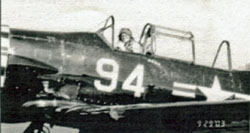
While employed with the airline, Captain Harris, in addition to probably being a wide variety of aircraft was also the Chief Accident Investigator for the Airline Pilots Association. He also served as the Air Safety Committee Chairman. In addition to being awarded the Airline Pilots Association International “Pilot of the Year” in 1979, he was appointed Chairman of the Cockpit Design Committee for the Boeing 757 in the 1980’s. Captain Harris retired from Eastern Airlines in 1985 and was #1 ranked Captain with over 35,000 flying hours. To the left is Captain Harris flying in celebration of this 80th birthday at Hanover Airport.
Captain Arnim L. Harris Jr. was recently inducted into the Virginia Aeronautical Historical Society Hall of Fame.
Post note: Captain Harris is not the first of his family to hold the title of Captain. He has traced his ancestry back to Captain Thomas Harris, early settler of Henrico County from the time of Sir Thomas Dale who held the first recorded patent for property known as Longfield, later to become Curles Neck.
>Back to Top<
USS Tangier - September, 2007
(Reprinted from Naval Historical Center website.)
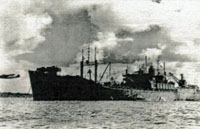
USS Tangier (AV-8): The USS Tangier, first of a class of three 11,760-ton seaplane tenders, was launched at Oakland, California in 1939 as the merchant ship Sea Arrow. Taken over by the Navy 1940, she remained at her builders’ for conversion work and went into full commission in August 1941.
Note a PBY patrol seaplane flying past below the bow and a seaplane on the aft deck in the far right of the photo.
Tangier went to Pearl Harbor in November and was employed supporting the expanded force of patrol seaplanes based there during a time of increasing tension with Japan. She was present during the December 7, 1941 air raid on Pearl Harbor and was slightly damaged when a Japanese bomb exploded nearby.
When the Japanese attacked Pearl Harbor on December 7, 1941, USS Tangier was moored astern of the USS Utah (AG-16). That ship was torpedoed and sunk, and the nearby seaplane tender Curtiss (AV-4) was hit by a bomb and a crashing enemy plane. However, Tangier’s only damage, from a bomb near-miss, was superficial. Her guns actively engaged Japanese planes, claiming to have shot down three, and also fired on an enemy midget submarine subsequently sunk by the destroyer Monaghan (DD-354). She also took part in rescue efforts during and after the attack.
About a week later, Tangier was sent toward Wake Island with supplies for its Marine garrison, but was recalled when Wake was captured by Japanese forces on December 23. In February 1942, the tender steamed to the South Pacific, where she stayed until June, maintaining seaplane patrols out of Noumea, New Caledonia. Her planes played a supporting role in the May 1942 Battle of the Coral Sea.
Following a West Coast overhaul, Tangier again was based in the South Pacific in February-August 1943, then served on transport duty between the war zone and the United States. From March 1944 until June 1945, the ship's base moved steadily forward from Australia to the Philippines as her seaplanes assisted the Seventh Fleet and General MacArthur's forces during their advance across New Guinea and northward.
Tangier was receiving the attentions of a statewide shipyard when the Pacific War ended in August 1945, but was sent back to the Far East to support occupation efforts from October 1945 into March 1946. She then made the long trip back to the US, passing through the Panama Canal and arriving at Norfolk, Virginia in late April. The next month, she began deactivation at Philadelphia, Pennsylvania. Tangier decommissioned there in February 1947 and remained in the Atlantic Reserve Fleet until 1961. In November of that year she was sold for scrapping.
>Back to Top<
The Virginia Aeronautical Historical Society - September, 2007
(Reprinted from the VAHS website)
The idea for the society was fostered by Morten W. Lester, a well-known Virginia aviation enthusiast from Martinsville, who saw the need to preserve and display rapidly disappearing aviation artifacts in Virginia. Lester soon found other Virginians who shared his vision to establish a Virginia Aeronautical Historical Society. On November 30, 1977, that vision became a reality when the Virginia Aeronautical Historical Society was launched by a group of interested Virginia citizens. The Society is permanently headquartered in the Virginia Aviation Museum at the Richmond International Airport.
The original purpose of the organization was to “study, research, interpret, preserve, and disseminate Virginia's aviation and aeronautical heritage, and to preserve, acquire, and display those items pertaining to Virginia’s aviation and aeronautical heritage”.
The objectives of the Virginia Aeronautical Historical Society are to:
1. Prepare, collect, and preserve documents, aircraft, aerospace vehicles, and other items which relate to the history of aviation and aerospace in Virginia, from its beginning to the present;
2. Educate the general public with emphasis on young people, on the contribution which Virginia has made and is making to the development in aviation and aerospace;
3. Provide aid and support to the Virginia Aviation Museum and those Virginia institutions; and
4. Promote aviation in Virginia.
To support the mission, the Virginia Aeronautical Historical Society operates and directs a number of programs.
- The Virginia Hall of Fame: one of the most successful projects sponsored by the Virginia Aeronautical Historical Society-the Hall of Fame-was created to honor Virginians who have made significant contributions to the development of aviation. New inductees are honored at an annual Hall of The Dinner hosted in November of each year.
- Historical Marker Program: Virginia is the site of many aviation firsts and one of the projects of the VAHS is to commemorate those sites with roadside historical markers. Working in conjunction with the Virginia Department of Transportation, a number have already been erected around the state commemorating such events as the first ship-to-shore flight, the first passenger flight, the first later-than-air flight in North America, and the unfortunate notice of the first aviation passenger fatality. Many other firsts are also on record in efforts are continuing to expand the number of these markers around the state.
- Oral History Project: so as not to be lost forever, the oral history program is the designed to interview and record the stories of Virginia's aviation pioneers and others instrumental in the state’s aeronautical advancement.
- Airport History Project: Virginia is the location of one of the earliest and many of the most important airports in the nation.
To commemorate these significant airports the society has published a book entitled Virginia Airports-A Historical Survey of Airports and Aviation from the Earliest Days by Vera Roster Rollo, PhD and Norman L. Crabill. To purchase this very informative 252 page book or for questions relating to the Society call the office at (804)222-8690 or e-mail vahs@smv.org>vahs@smv.org.
>Back to Top<
Richmond Magazine's Best & Worst Award for 2007 - September, 2007
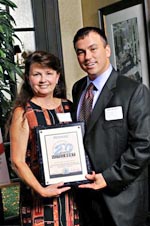
We are honored to report the Henrico County Historical Society and the Preservation for Henrico Antiquities were chosen number 18 out of 20 of the Object of Affection-Editor's Pick for 2007 in the August issue of Richmond Magazine.
This is a special issue because it celebrates the 20th anniversary of the good, the bad, and the ugly in the Richmond region.
A reception was held at Ruth’s Chris Steak House and was well attended by corporate sponsors and community leaders.
HCHS and APHA were presented with the award for having “raised their collective voices to protect this developing county’s precious heritage. This ranges from urging protection of the Tree Hill Farm plantation and the Powhatan sites along Route 5 to getting ahead a Henrico County historic landmark designation for the Markel Building near the Willow Lawn.” Pictured left are HCHS President, Sarah Pace and Son, HCHS member Jim Kennedy having accepted the award.
(Photo courtesy of Nancy Parker, Expressions Photography, Inc.)
It is reassuring to know that our collective voices are being heard. Go, team, go! Grab a copy and check it out. Page 85 to be exact.
>Back to Top<
Cemetery Committee Announcement, September 2007
It has come to the attention of the Cemetery Committee that there are a couple family cemeteries possibly threatened with development plans. The Ford-Tinsley Family Cemetery on Mountain Road and the Ryall Family Cemetery located on Bent Pine Road, Glen Allen. If anyone has additional information, please contact Vicki Stephens at (804)227-3673 or arnim@westhanover.net.
>Back to Top<
September 2007 Third Quarterly Meeting
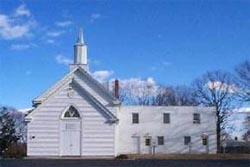
The next meeting of the Henrico County Historical Society will be held Sunday, September 9, 2007, 2:30 p.m. in the sanctuary of the Deep Run Baptist Church, 10907 Three Chopt Road; the church is pictured left. After a short business meeting, we will have a presentation on the history and moving of the Springfield Baptist Church including photos and a video as well as the history of Deep Run Baptist Church. Light refreshments will be provided.
Built in 1742, Deep Run Baptist Church was established as an Episcopal chapel. It was modeled after St. John's Church in Richmond, and constructed with wooden pegs and beams which remain part of the present structure. It is reported that during the Revolutionary War, the church served as a hospital for wounded soldiers as well as a gathering place for Lafayette at one time. In 1791, the Dover Association constituted “Hungry Church”, the original name of Deep Run, from Chickahominy Church (now Winn’s in Hanover County). In 1819, the name of the church was officially changed to Deep Run.
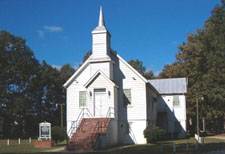
Springfield Baptist Church’s origin goes back to 1882. This church was destined for the bulldozer until HCHS representatives made connections with the Field Day of the Past organization and APVA Preservation Virginia who negotiated with the developer, Atlantic Development. The property had been purchased three years ago by Atlantic Development for the purpose of developing a small shopping center. The saving of Springfield Baptist Church was the result of a community working together to preserve part of its heritage.
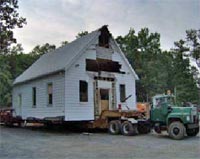
Just weeks ago, the church, roof on one flatbed truck and the building on another, made the trek down West Broad Street to its new home at Field Day of the Past show grounds on Ashland Road in Goochland County. The project relied solely on volunteer labor and cooperatives weather, and involved removing the roof, bell tower and steeple in addition to building a stabilizing wall.
The church sold the property three years ago and now meets at J. R. Parker High School, with hopes of eventually building a new sanctuary.
Church members have mixed emotions about moving their beloved church from the site but knew selling the church made the most sense for the congregation. The Springfield Baptist Church continues to maintain the cemetery on the grounds and is guaranteed access in perpetuity.
Audrey Winston, who has been referred to as Springfield Baptist Church’s historian, said she looks forward to visiting the Goochland site next month to discuss how the church should be interpreted. Winston was quoted as saying, “Having to leave was an emotional time, and to realize it is going to be restored and placed on some historical property was a relief. We know it will always be there.”
The church is a fine addition to the Field Day show grounds. It will sit proudly among other period buildings and be one of only a few predominantly African-American churches from its era that remain locally.
>Back to Top<
News 2007: Third Quarter
First Quarter | Second Quarter | Fourth Quarter
Home | Henrico | Maps | Genealogy | Preservation | Membership | Shopping | HCHS
|











